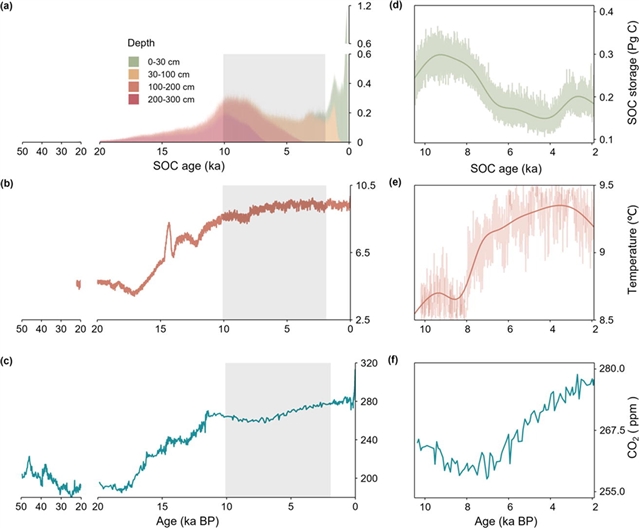
中国科学院青藏高原研究所丁金枝团队研究了全新世早期土壤有机碳积累高峰。相关论文于2025年6月16日发表在《科学通报》杂志上。
土壤具有通过固存有机碳来降低大气二氧化碳浓度的巨大潜力,但它对全新世大气二氧化碳波动的贡献一直是人们猜测的问题。研究组探索了5190个放射性碳数据和442737个土壤有机碳(SOC)含量观测值的分析,以可视化SOC的全球丰度-持久性谱及其深度分布。结果发现,现今的土壤碳库自晚更新世以来开始积累,并在大约8-1万年前的全新世早期达到峰值。
高纬度地区含有大量的古代碳,即使在浅层土壤中也是如此,冰川后植被恢复和泥炭地开发推动了最大程度的固碳,这有助于减少全新世早期的二氧化碳和温度波动。然而,更高的温度对应于全新世碳积累的抑制,这意味着持续的全球变暖可能会进一步耗尽土壤碳库,威胁土壤碳封存的可持续性。
附:英文原文
Title: Peak accumulation of soil organic carbon in the early Holocene
Author: Jinzhi Ding a
Issue&Volume: 2025/06/16
Abstract: Soil holds significant potential to mitigate atmospheric CO2 concentrations through the sequestration of organic carbon, yet its contribution to fluctuations in atmospheric CO2 over the Holocene has been a matter of much speculation. Here we explored analyses of 5190 radiocarbon data and 442,737 content observations of soil organic carbon (SOC) to visualize the global abundance-persistence spectrum of SOC and its depth distribution. We found that the present-day soil carbon pool began to accumulate since the Late Pleistocene and reached its peak accumulation in the early Holocene, approximately 8–10 thousand years ago. High-latitude regions contain significant amounts of ancient carbon, even in shallow soil layers, with maximum sequestration driven by post-glacial vegetation recovery and peatland development, which contributed to reducing CO2 and temperature fluctuations during the early Holocene. However, higher temperatures correspond to suppressed carbon accumulation in the Holocene, implying that ongoing global warming may further deplete soil carbon pools and threaten the sustainability of soil carbon sequestration.
DOI: 10.1016/j.scib.2025.05.046
Source: https://www.sciencedirect.com/science/article/abs/pii/S2095927325006188
Science Bulletin:《科学通报》,创刊于1950年。隶属于SciEngine出版平台,最新IF:18.9
官方网址:https://www.sciengine.com/SB/home
投稿链接:https://mc03.manuscriptcentral.com/csb
